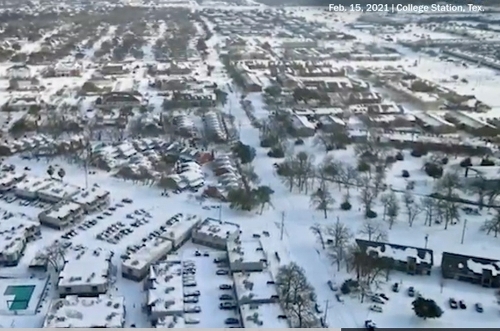
Delaware Beware: Likely Causes of Texas Electric Grid Blackouts
Center for Energy & Environmental Policy
February 17, 2021 (photo source: Washington Post Video)
Besides Texas, blackouts occurred last year in California, Europe, and Japan, all with wind and solar power making up about 25% of their electric grids.
Delaware just increased its wind and solar mandate from 25% to 40%, and discussions are being held to go to 50%. Beware following this path.
A full explanation of the Texas blackouts will likely await an investigation by the Electric Reliability Council of Texas (ERCOT).
The following is a summary of the likely contributing causes:
- Inadequate control and weatherization of natural gas supply
- Over-reliance on unreliable wind and solar power
- Over-reliance on a demand response mechanism
It is fair to ask how an electric grid with 128,000 megawatts (MW) of electric generating capacity only managed to have about 35,000 MW online, about half of the actual demand?
You may hear the blame being put on record cold temperatures, but a similar cold snap occurred in 2011, and the weather in the 1940s may have been worse.
The table below shows the generation mix as of November 2020.
|
|
During very cold weather, wind speeds fall dramatically, and ERCOT only expected 7% of generation capacity from wind. Cloudy weather limited solar generation.
It turns out only about half the natural gas capacity was available, reducing total capacity to 59,000 MW compared to 69,000 in demand. ERCOT raised power prices to the $9,000/megawatt-hour cap from the usual $25 to $50 range to discourage use.
ERCOT can call on large industrial electric customers to curtail use. Still, the reaction just wasn’t fast enough, so circuits either tripped or were shut down by ERCOT. Texas is unique in having almost no connection to power from other states in an emergency.
In winter, much of the natural gas supply goes directly into heating furnaces reducing supply for power plants. There is very little storage for natural gas. Instead, new production is supposed to keep the pipeline full, and high compression pressures increase capacity in the pipelines themselves. Cold temperatures froze wells and pipeline valves reducing volume, and pressure.
As recently as 2015, coal capacity was 40% higher, but coal plants have been shut down. After the 2011 weather event, a study recommended winterization infrastructure be added, but additions were only partially implemented.
Going forward, ERCOT needs to get serious about completing weatherization improvements instead of continuing to add more unreliable wind and solar power.
|
